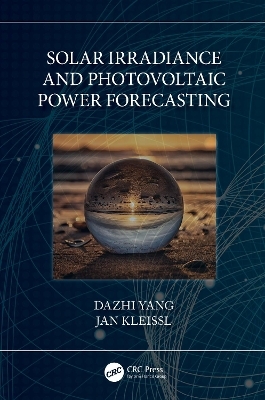
Solar Irradiance and Photovoltaic Power Forecasting
CRC Press (Verlag)
978-1-032-06812-1 (ISBN)
Forecasting plays an indispensable role in grid integration of solar energy, which is an important pathway toward the grand goal of achieving planetary carbon neutrality. This rather specialized field of solar forecasting constitutes both irradiance and photovoltaic power forecasting. Its dependence on atmospheric sciences and implications for power system operations and planning make the multi-disciplinary nature of solar forecasting immediately obvious. Advances in solar forecasting represent a quiet revolution, as the landscape of solar forecasting research and practice has dramatically advanced as compared to just a decade ago.
Solar Irradiance and Photovoltaic Power Forecasting provides the reader with a holistic view of all major aspects of solar forecasting: the philosophy, statistical preliminaries, data and software, base forecasting methods, post-processing techniques, forecast verification tools, irradiance-to-power conversion sequences, and the hierarchical and firm forecasting framework. The book’s scope and subject matter are designed to help anyone entering the field or wishing to stay current in understanding solar forecasting theory and applications. The text provides concrete and honest advice, methodological details and algorithms, and broader perspectives for solar forecasting.
Both authors are internationally recognized experts in the field, with notable accomplishments in both academia and industry. Each author has many years of experience serving as editors of top journals in solar energy meteorology. The authors, as forecasters, are concerned not merely with delivering the technical specifics through this book, but more so with the hopes of steering future solar forecasting research in a direction that can truly expand the boundary of forecasting science.
Professor Dazhi Yang received the B.Eng., M.Sc., and Ph.D. degrees from the Department of Electrical Engineering, National University of Singapore, Singapore, in 2009, 2012, and 2015, respectively. He is currently a Professor with the School of Electrical Engineering and Automation, Harbin Institute of Technology, Harbin, China. He has authored more than 130 journal articles, among which many are ESI highly cited papers. He is the current Subject Editor of Solar Resources and Energy Meteorology for the Solar Energy Journal, where he has handled over 1800 submissions. He is also an active participant of the International Energy Agency, Photovoltaic Power Systems Programme, Task 16: Solar Resource for High Penetration and Large Scale Applications. Over several consecutive years, Dazhi Yang has been listed as one of the world's top 2% scientists (for both single year and career) by Stanford University. Similarly, he has also been consecutively listed as one of the world's top 100,000 scientists published by the Global Scholars Database. His research interests are diverse, including but are not limited to forecasting, energy meteorology, grid integration, multi-energy systems, satellite remote sensing, spatio-temporal statistics, thermochemistry, battery thermal management and fault diagnosis, electromagnetic compatibility, and cultural heritage. Among these directions, he achieved the most success in solar forecasting: At the moment, he has the most journal publications on solar forecasting in the world. Professor Kleissl researches the interaction of weather with engineering systems in buildings, solar power systems, and the electric power grid. Kleissl's solar variability models, sky imager solar forecasting tools, and numerical weather prediction solar forecasts have been commercialized or used operationally to advance solar power integration. Kleissl received an undergraduate degree fromthe University of Stuttgart and a PhD from the Johns Hopkins University, both in environmental engineering with a focus in environmental fluid mechanics. He is the Director of the UC San Diego Center for Energy Research, Professor in the Department of Mechanical and Aerospace Engineering at UC San Diego. Kleissl has published over 100 papers in the top journals of solar power resources, forecasting, and integration. Kleissl and his students and postdocs developed one of the first and most successful PV variability models for large solar power plants. The model has been released open source in Sandia National Lab's PV-Lib toolbox and used by 100s of researchers and practitioners globally. Kleissl also pioneered the field of sky imager forecasting and developed some of the most advanced physics-based modeling tools for sky imagery. In numerical weather prediction, Kleissl's group specializes in Stratocumulus clouds and their representation in simple and complex models of the atmosphere.Recently Kleissl focused on PV integration into electric distribution systems and developed optimal voltagecontrol techniques for smart solar PV inverters. In 2012 Kleissl became Associate Editor and in 2015 Subject Editor for Solar Resources and Energy Meteorology for the Solar Energy Journal, where he handled over 1,200 articles and was recognized for efficiency, impartiality, and quality. In 2017 Kleissl was invited to act as guest editor-in-chief for the Solar Energy Journal special issue "Advances in Solar Resource Assessment and Forecasting" that was published in July 2018. Kleissl has been deputy editor for the AIP Journal of Renewable and Sustainable Energy since 2019
1 Why we do solar forecasting. 2 Philosophical thinking tools. 3 Deterministic and probabilistic forecasts . 4 Solar forecasting: The new member of the band . 5 A guide to good housekeeping. 6 Data for solar forecasting. 7 Base methods for solar forecast generation. 8 Post-processing solar forecasts. 9 Deterministic forecast verification. 10 Probabilistic forecast verification. 11 Irradiance-to-power conversion with physical model chain. 12 Hierarchical forecasting and firm power delivery
| Erscheinungsdatum | 01.08.2023 |
|---|---|
| Reihe/Serie | Energy Analytics |
| Zusatzinfo | 42 Tables, black and white; 141 Line drawings, black and white; 9 Halftones, black and white; 150 Illustrations, black and white |
| Verlagsort | London |
| Sprache | englisch |
| Maße | 156 x 234 mm |
| Gewicht | 1419 g |
| Themenwelt | Naturwissenschaften ► Physik / Astronomie |
| Technik ► Elektrotechnik / Energietechnik | |
| Technik ► Umwelttechnik / Biotechnologie | |
| ISBN-10 | 1-032-06812-4 / 1032068124 |
| ISBN-13 | 978-1-032-06812-1 / 9781032068121 |
| Zustand | Neuware |
| Informationen gemäß Produktsicherheitsverordnung (GPSR) | |
| Haben Sie eine Frage zum Produkt? |
aus dem Bereich


